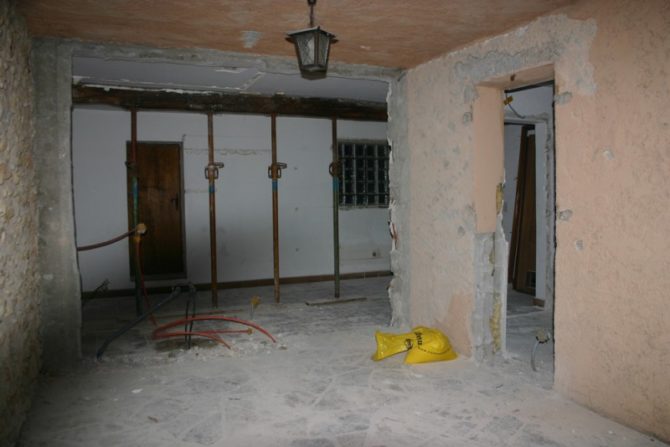Fixing It Up In France

When we bought our house in France more than three years ago, it was with the intention of bringing the property into the 21st century. The stone village house was seriously dated and included rooms that could only be described as hideous. The bathroom had thick brown tiles that you wouldn’t wish on your worst enemy, and the kitchen consisted of two cupboards, a sink and an oven the size of a microwave. There was also a considerable waste of space in the layout of the rooms, which became all the more apparent as our family grew from three to five.
So after considerable scrimping and saving we embarked on our renovation project. But before we got our hands dirty, so to speak, we paid a visit to the local real estate agent to ask him to come and evaluate the house. We needed to make sure that the money we were planning to spend on the property would add value—imperative for any renovation project, says Wouter Haaijman, from French Property Surveyors.
“Right at the start you need to know if a renovation project is going to make financial sense,” says Haaijman. “If for example you wanted to buy a derelict barn for €25,000 and spend €175,000 on the work—but could then expect to sell it for €300,000 it makes excellent sense. But if the resale price is lower than €225,000, it’s a no-goer. And you must also bear in mind that you have to allow 10% to 20% of the total renovation budget as a margin for errors.”
We got the thumbs up on the plans for our project, and so we started to contact local builders for their devis, or price estimates. This was a much less daunting experience than it might have been, because we had lived in the area for five years or so, and were able to seek out local tradesmen who knew the village, where to go for materials and who had to be contacted at the Mairie (City Hall) for permission. Newcomers to an area often have a much harder time finding the right people.
A devis should be quite detailed, showing prices and the TVA (value added tax) for each separate item of work. We found that some builders are not as meticulous as others, and there were huge discrepancies in the total amount—in one case as large as €40,000! After days of wrangling with figures, we made our decision, and signed a copy of the devis, which then becomes a fixed-price contract.
It’s also important when choosing builders to check that they have the right paperwork and insurance. “They must be properly registered in France, with a verifiable SIRET number,” explains Haaijman. (A SIRET number is a commercial tax identity code.) “They also need to have décennale insurance, which covers the work carried out for up to ten years, as well as personal liability insurance in case of an accident during the project.”
Using a legitimate, registered French builder also means that renovation costs can be set against any perceived gain on the resale of the property in calculating French capital gains tax.
It is also wise to get a structural surveyor—expert de structure—to carry out a full survey of the property. Although in France it isn’t usual for surveys to be done, Louise Sayers of Med and Mountain Properties says she always recommends that buyers get an expert to carry out a thorough examination of the building. “The norm for French buyers is just to have the property looked over by a builder. They also rely heavily on reports that have to be carried out by the seller—a number of reports are required, such as a lead report, an asbestos report and an energy efficiency report. But there are lots of English speaking surveyors available in France, and we always recommend that you get a full and detailed survey,” says Sayers.
In the US it is usual for the bank or savings and loan association lending the money for the property purchase to carry out its own valuation. This is not the case in France. Some lenders will commission a brief valuation report, but only for their own lending purposes. The buyer will not normally receive a copy of it, and that’s even more reason to get your own structural survey carried out, adds Sayers.
So, with our builders chosen and all their credentials checked, we set about transforming the house. The extent of the work—and all the dust that ensued—meant that we had to move out into rented accommodation. This was incredibly hard to find for a short-term rental of three months. We tried all avenues, including a mobile home on a campsite and even that was fully booked—even in the harsh depths of winter. We eventually found the house of a friend of a friend, which is currently for sale. The rent was much more than we had budgeted for—another expense you might have to include in your planning.
Our builders, Kevin and Laurent, were fantastic in helping us tackle the Mairie for permission to alter our house. In a historic old village, there is very little that can be done to a house’s facade, and planning permission is notoriously hard to secure. But since we were primarily changing the use of the interior of the property, we were allowed to do so with only a déclaration de travaux (statement of repair work).
A permis de construire (construction permit) is required for a new build or any extension with a surface area greater than 20 square meters (215 square feet). A permis de constuire is also needed if you intend to change the use of an existing structure, for example if you plan to convert a barn or a stable into living accommodation.
With all the formalities and paperwork out of the way, the fun began. It is surprisingly satisfying to tear out the kitchen you so loathed and discard it into a benne (big construction bin), along with the revolting bathroom tiles that have ruined many a bath time. Surprising too was the speed at which Kevin and Laurent ripped our beloved house apart. The demolition phase, which included removing a structural wall, took less than two weeks. They worked pretty flat out most of the ti
me, but beware, building workers can be rather like escargots: they seem to hibernate when the rain clouds gather.
While Kevin and Laurent prepared the rooms, my husband and I traipsed around to building suppliers and hardware shops looking for the new kitchen and bathroom furnishings and flooring. After waiting three years to do this, I expected the experience to be up there with some of the most enjoyable of my life. How wrong I was. Perhaps this had something to do with the three children under seven that we were dragging around with us. Or the shocking expense of it all.
But somehow we got there in the end, with a kitchen from IKEA, a bathroom from Lapeyre and wood flooring from a local shop in Cagnes-sur-Mer.
The kitchen caused a few nightmares for Kevin and Laurent as they tried to install it, not least because we had started without a plan and therefore didn’t realize that the false ceiling they put in was too low for the kitchen units. A clever rethink over the height of the units’ feet eventually allowed it all to fit in.
The unevenness of the walls in our house, some parts of which are hundreds of years old, also caused us a few sleepless nights. The kitchen work surface had to be cut into the wall and as a result, the simple IKEA kitchen took much longer to complete than envisaged.
As did the levelling of the floor. As did the drying of the plaster in the bathroom. As did the electrical rewiring…. A pattern began to emerge.
Even though we had been warned time and time again, we learned the hard way. It is virtually impossible to stick to a timetable, since so many things can go wrong, and time means money.
Luckily for us—and due solely to the hard work of our builders—we finished the project with most of the major work completed on time. Where we cut corners was in the finishings—there is a great deal of painting still to be done, as well as floors to be fitted, which my husband and I are trying to do after work and on weekends. Again, not easy with three kids underfoot, but they are more than happy about it all—their new play area is a big hit. And at the end of a hard day, relaxing in the brand new, brilliant white bathroom makes it all worthwhile.
Originally published in the April 2010 issue of France Today.
Share to: Facebook Twitter LinkedIn Email



